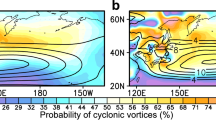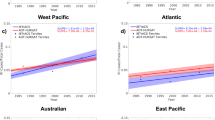Abstract
WHILE the subject of cyclones is being discussed in NATURE, I should like to direct attention to a point which I have already treated in a paper read before the Royal Society of Edinburgh in January, 1916. It is there pointed out that though the core of a cyclone is colder than the core of an anticyclone or than the surrounding air, yet the air in the cyclone is lighter than that in the anticyclone. This decrease in density is due to the air being under a lower pressure. It is shown that the lower pressure in cyclones more than compensates for their lower temperature, so that though the air in cyclones is colder, yet it is lighter than the surrounding air, and tends to ascend in the troposphere as well as in the stratosphere.
This is a preview of subscription content, access via your institution
Access options
Subscribe to this journal
Receive 51 print issues and online access
$199.00 per year
only $3.90 per issue
Buy this article
- Purchase on SpringerLink
- Instant access to full article PDF
Prices may be subject to local taxes which are calculated during checkout
Similar content being viewed by others
Author information
Authors and Affiliations
Rights and permissions
About this article
Cite this article
AITKEN, J. Cyclones. Nature 102, 425 (1919). https://doi.org/10.1038/102425b0
Issue date:
DOI: https://doi.org/10.1038/102425b0



